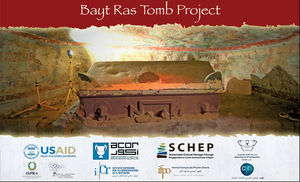"Bayt Ras Tomb" project
The Department for the Geological Survey of Italy provide technical-scientific support to the Department of Antiquities of Jordan for the restoration and conservation of a Roman painted tomb of exceptional archaeological and historical value, recently discovered in Bayt Ras (N Jordan).
The ‘Bayt Ras’ Project, funded by USAID through the SCHEP Programme (Sustainable Cultural Heritage through Engagement of local communities Project) is aimed at the restoration and conservation of a Roman painted tomb discovered in 2016 in Bayt Ras, the ancient Capitolias, close to Irbid (N Jordan). An international team composed by experts of several institutions (ISPRA, DOA, ACOR, ISCR, IFPO, CNRS) has been established for the studies and conservation of the Bayt Ras hypogeum. Following the long-term cooperation between ISPRA and the Department of Antiquities of Jordan (DOA) since 2009, for the geological conservation of the Cultural Heritage in Jordan, ISPRA have provided support for geological, geophysical and geotechnical analyses as a preliminary and fundamental aspects to be considered for the sustainable conservation and future tourist exploitation of the tomb.
The hypogeum is formed by two burial chambers which are still in a good state of conservation. The ceiling and the walls of the main chamber contain mythological paintings and images that describes the construction of the ancient Capitolias and represent a unique example due iconographic richness and presence of numerous inscriptions. As a matter of fact, the Bayt Ras tomb can be defined as the most ancient graphic novel of history.
The structure, carved inside a limestone rock, presents, in the area of the original access door, numerous open cracks that caused the detachment and loss of a part of the frescoes. During the initial phase of the project (2017-2019), an engineering geological investigation has been coordinated and implemented by ISPRA, Department for the Geological Survey of Italy in distinct geological, geophysical and geotechnical field surveys aimed at: (
a. detection of further potential underground structures located around the hypogeum and in a wider adjacent area as part of a likely ancient necropolis;
b. analysis of lithological, structural and geomechanical characteristics of the limestone rock and implementation of a static-structural analysis;
c. installation of a monitoring system for the control of cracks displacements inside the hypogeum.
A second phase of the project (2021-2023) considers the implementation of a Master Plan with further site investigations, restoration works and structural consolidation for a long-term protection, sustainable and safe tourist exploitation of the Bayt Ras tomb.

